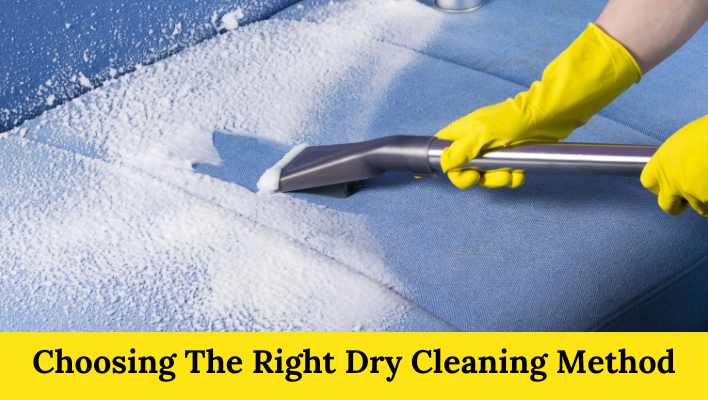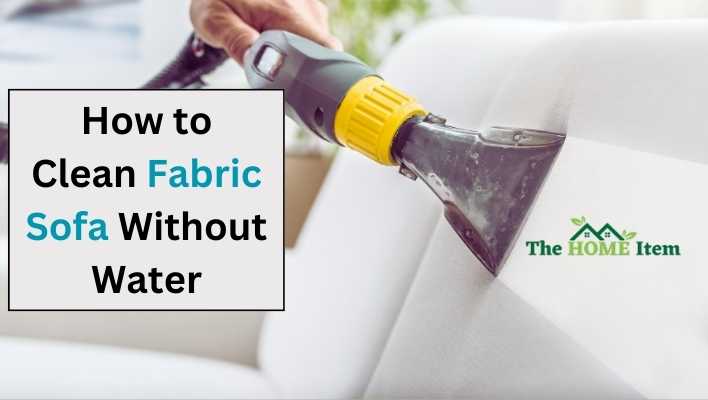To clean a fabric sofa without water, use a dry cleaning solvent and a soft brush to gently remove stains and dirt. When it comes to cleaning a fabric sofa without water, you can achieve great results by using a dry cleaning solvent and a soft brush.
This method allows you to effectively remove stains and dirt from your sofa without risking any water damage. By following a few simple steps, you can keep your fabric sofa clean and fresh without the need for water. We will explore how to effectively clean your fabric sofa without water, providing you with a step-by-step guide to tackle stubborn stains and maintain a clean and inviting piece of furniture.
Table of Contents
The Benefits Of Dry Cleaning
Discover the advantages of dry cleaning for your fabric sofa, eliminating the need for water. Safely and effectively clean your furniture without the hassle of wet cleaning methods. Experience the benefits of dry cleaning today.
Discover Why Dry Cleaning Is A Great Alternative To Water-based Methods
When it comes to cleaning your fabric sofa, there are various methods you can choose from. One popular option that you may not have considered is dry cleaning. Dry cleaning offers several benefits over traditional water-based methods, making it an excellent choice for maintaining the cleanliness and longevity of your fabric sofa. In this article, we will explore the advantages of dry cleaning for fabric sofas and why it is a great alternative to water-based cleaning techniques.
Exploring The Advantages Of Dry Cleaning For Fabric Sofas
Dry cleaning is a specialized cleaning process that utilizes solvents to remove dirt, stains, and odours from fabric without the need for water. This unique method offers several advantages that make it a preferred choice among homeowners. Let’s take a closer look at the benefits of dry cleaning:
| Advantages of Dry Cleaning for Fabric Sofas |
|---|
| Delicate fabric-friendly |
| Prevents shrinkage or stretching |
| Eliminates the risk of water stains |
| Efficient stain removal |
| Reduces drying time |
| Eliminates unpleasant odors |
Delicate fabric-friendly: Dry cleaning is especially suitable for delicate fabrics that may be easily damaged or discoloured by water. The gentle solvent-based solution used in dry cleaning effectively lifts dirt and grime without causing any harm to sensitive materials.
Prevents shrinkage or stretching: Unlike water-based methods, dry cleaning minimizes the risk of your fabric sofa shrinking or stretching during the cleaning process. This is particularly crucial for maintaining the original shape and size of your sofa, ensuring its long-term durability.
Eliminates the risk of water stains: Water stains can be a nightmare to deal with on fabric sofas. Dry cleaning eliminates the need for water, effectively eradicating any chance of water stains or water damage to your furniture. This gives you peace of mind, knowing that your sofa will remain pristine and free from unsightly water markings.
Efficient stain removal: Dry cleaning solvents are specifically formulated to target and eliminate even the toughest stains from your fabric sofa. Whether it’s spilt coffee, wine, or stubborn food stains, dry cleaning can effectively lift and remove them, leaving your sofa looking fresh and stain-free.
Reduces drying time: With dry cleaning, you won’t have to worry about waiting for your sofa to dry thoroughly. Since there is no water involved, the drying time is significantly reduced compared to traditional cleaning methods. This means you can quickly enjoy your clean and fresh sofa without any inconvenience.
Eliminates unpleasant odours: Dry cleaning not only removes stains but also eliminates unpleasant odours that may have penetrated deep into the fabric. The solvents used in the dry cleaning process effectively neutralize odours, leaving your sofa smelling clean and fresh.
By understanding the benefits of dry cleaning for fabric sofas, you can now see why it is a great alternative to water-based cleaning methods. I hope this article has given you insight into the advantages of dry cleaning so that you can make an informed decision when it comes to keeping your fabric sofa clean and well-maintained.
Read Also: How to Clean Your Ashley Sofa: Expert Tips and Tricks
Preparing Your Sofa For Deep Cleaning

Clearing The Surface Of Any Loose Debris
Before deep cleaning your fabric sofa, it’s important to start with a clean surface. Begin by clearing the sofa of any loose debris, such as crumbs, pet hair, or dust. You can use your hand or a soft brush to gently sweep the surface and remove any visible dirt. Be thorough in this step, as it will help prevent dirt from getting further embedded in the fabric during the cleaning process.
Vacuuming The Sofa To Remove Dirt And Dust Particles
Once the loose debris has been cleared, it’s time to give your sofa a thorough vacuuming. Using a vacuum cleaner with a brush attachment, start from the top and work your way down, covering all areas of the sofa. Pay special attention to the crevices and corners where dirt tends to accumulate. Vacuuming will help remove dirt, dust particles, and allergens that may be trapped in the fabric.
Identifying And Treating Stains Before Cleaning
Before proceeding with the deep cleaning process, it’s essential to identify any stains on your fabric sofa and treat them individually. Carefully inspect the surface and mark any areas that need attention. Depending on the type of stain, you can use appropriate stain removers or natural remedies to treat them. Remember to always test any product or solution in a hidden area of the fabric before applying it to the stain directly.
Choosing The Right Dry Cleaning Method For Your Sofa

When it comes to cleaning your fabric sofa without water, it’s important to choose the right dry cleaning method. This ensures that your sofa stays clean and fresh without risking any damage to the fabric. In this section, we will explore the different dry cleaning options available, how to evaluate the fabric type and its cleaning requirements, and how to select the appropriate dry cleaning products or techniques.
Understanding The Different Dry Cleaning Options Available
Before you start cleaning your fabric sofa without water, it’s important to understand the different dry cleaning options available. Each method has its own benefits and considerations, so it’s essential to choose the one that best suits your sofa’s needs.
- Dry powder cleaning: This method involves using a dry cleaning powder that is sprinkled onto the fabric. The powder is then brushed or vacuumed off, taking dirt and stains along with it.
- Dry foam cleaning: With this method, a foam cleaner is applied to the fabric. The foam is worked into the sofa using a brush or sponge and then vacuumed away, leaving the fabric clean and fresh.
- Carbonated cleaning: This method uses a carbonated solution that is applied to the fabric. The solution creates bubbles that help to lift dirt and stains from the fabric, which can then be wiped away.
Evaluating The Fabric Type And Its Cleaning Requirements
Before you proceed with any dry cleaning method, it’s crucial to evaluate the fabric type and its cleaning requirements. Different fabrics have different cleaning needs, and using the wrong method can lead to discolouration, damage, or even shrinkage.
Here are some fabric types commonly found in sofas and their corresponding cleaning requirements:
| Fabric Type | Cleaning Requirements |
|---|---|
| Cotton | Gentle cleaning methods and specific fabric cleaners suitable for cotton. |
| Polyester | Non-abrasive cleaning with specific polyester-friendly products. |
| Microfiber | Regular vacuuming and spot cleaning with a microfiber-specific cleaner. |
| Leather | Specialized leather-cleaning products or professional cleaning for delicate leather sofas. |
Selecting The Appropriate Dry Cleaning Products Or Techniques
Once you have assessed the fabric type, it’s time to select the appropriate dry cleaning products or techniques. The market offers a variety of dry cleaning products that are specially formulated for different fabric types.
Some considerations when choosing dry cleaning products or techniques include:
- Check the product labels for compatibility with your fabric type.
- Testing the product on a small, inconspicuous area of the sofa to ensure it does not cause any adverse effects.
- Following the manufacturer’s instructions carefully to get the best results.
By understanding the different dry cleaning options available, evaluating the fabric type and its cleaning requirements, and selecting the appropriate dry cleaning products or techniques, you can ensure that your fabric sofa is effectively cleaned without the use of water while maintaining its pristine condition.
Step 1: Dry Cleaning Solution Application
When it comes to cleaning your fabric sofa without water, the first step is to apply a dry cleaning solution. This solution is specifically designed to remove dirt, stains, and odours from your sofa, leaving it looking fresh and clean. Follow these simple steps to ensure a thorough and effective cleaning process:
Applying The Dry Cleaning Solution Evenly Across The Sofa
To start, you need to evenly distribute the dry cleaning solution on your fabric sofa. This can be done by using a spray bottle or by pouring a small amount of the solution onto a clean, soft cloth. Begin by spraying or dabbing the solution onto a small, inconspicuous area of the sofa to test for colour fastness. If there is no colour transfer or damage, proceed to apply the solution evenly across the entire surface of the sofa.
Use a Soft Brush Or Cloth To Work The Solution Into The Fabric
Once the dry cleaning solution is applied, it is important to use a soft brush or cloth to work the solution into the fabric. This will help to break down any dirt or stains that may be embedded in the fibres. Gently scrub the surface of the sofa in a circular motion, paying extra attention to any areas that are particularly soiled. Be sure to use light pressure to avoid damaging the fabric.
Allowing The Solution To Sit For The Recommended Amount Of Time
After working the dry cleaning solution into the fabric, it is crucial to allow it to sit for the recommended amount of time. This time period will vary depending on the specific product you are using, so be sure to read the instructions carefully. Allowing the solution to sit will give it ample time to penetrate the fabric and lift any dirt or stains, ensuring a thorough cleaning process.
In conclusion, the first step in cleaning your fabric sofa without water involves applying a dry cleaning solution. By following these simple steps, you can effectively remove dirt, stains, and odors from your sofa, leaving it looking fresh and clean. Remember to test for color fastness, use a soft brush or cloth to work the solution into the fabric, and allow the solution to sit for the recommended amount of time for optimal results.
Step 2: Vacuuming And Brushing Away Residue

After applying the dry cleaning solution to your fabric sofa in Step 1, it’s time to move on to the next crucial step: vacuuming and brushing away residue. This step ensures that any remaining dirt, dust, or cleaning solution is thoroughly removed, leaving your sofa fresh and clean. Follow the instructions below to effectively complete this step.
Using A Vacuum Cleaner To Remove The Dry Cleaning Solution
To begin with, you’ll need a vacuum cleaner equipped with an upholstery attachment. This attachment should have soft bristles or a brush specifically designed for use on fabric surfaces. The vacuum cleaner will help you remove the dry cleaning solution and any loosened dirt or dust particles.
Start by attaching the upholstery tool to your vacuum cleaner. Make sure it is clean and in good condition. Then, switch on the vacuum and gently run the attachment over the surface of the fabric sofa. Ensure that you cover all areas of the sofa, including the sides, back, and cushions. The suction power of the vacuum will lift away the dry cleaning solution, dirt, and dust, leaving your sofa cleaner and refreshed.
Gently brush the Fabric To Ensure All Residue Is Eliminated
Once you have vacuumed the sofa, it’s important to gently brush the fabric to ensure all residue is eliminated. This step helps to remove any remaining dry-cleaning solution that might have seeped deeper into the fabric.
Using a soft-bristled brush or a clean, dry cloth, gently brush or rub the fabric in a circular motion. This will help to dislodge any stubborn dirt or residue that may have been left behind. Be careful not to apply too much pressure or scrub vigorously, as this could damage the fabric. Take your time and be thorough, paying attention to any areas that appear stained or soiled.
Checking For Any Remaining Stains Or Spots
After vacuuming and brushing, it’s important to inspect the fabric sofa for any remaining stains or spots. If you notice any stubborn stains or spots that haven’t been fully removed, you may need to repeat the dry cleaning solution application or consider using a targeted stain remover specific to the type of fabric.
Take a close look at the fabric under good lighting, and if needed, refer to the manufacturer’s instructions for stain removal on your specific fabric. Acting quickly on stains can prevent them from setting in and becoming more difficult to remove in the future.
Remember, cleaning your fabric sofa without water not only helps to preserve its quality and appearance but also reduces the risk of damage, such as shrinking or colour fading. By following these steps, you can effectively vacuum and brush away residue, ensuring your sofa stays fresh and inviting for many years to come.
Step 3: Upholstery Protection And Maintenance
Step 3: Upholstery protection is crucial for maintaining a clean fabric sofa without water. Follow these guidelines to ensure the longevity of your sofa and keep it looking its best.
Now that you have successfully cleaned your fabric sofa without water, it’s time to focus on protecting and maintaining its pristine condition. Upholstery protection is essential to prevent future stains and damage, while regular maintenance will help extend the lifespan of your sofa. Additionally, it’s crucial to follow proper care instructions based on the specific fabric type of your sofa to avoid any unnecessary damage.
Applying Fabric Protectant To Prevent Future Stains And Damage
One of the best ways to keep your fabric sofa looking fresh and clean is by applying a fabric protectant. This extra layer of protection helps to repel liquids, prevent stains from setting in, and guard against everyday wear and tear. To apply fabric protectant to your sofa, follow these simple steps:
- Ensure your sofa is clean and dry.
- Read the manufacturer’s instructions on the fabric protectant bottle to determine the appropriate amount needed for your sofa.
- Using a clean, lint-free cloth, apply the fabric protectant evenly across the entire surface of the sofa.
- Allow the protectant to dry completely before using the sofa.
Regular Maintenance Tips To Keep Your Sofa In Top Condition
To ensure your fabric sofa stays in top condition, regular maintenance is key. Here are some tips to incorporate into your sofa care routine:
- Remove any loose debris or crumbs from the sofa using a soft brush or vacuum cleaner with a brush attachment.
- Flip and rotate the cushions regularly to distribute wear and prolong their lifespan.
- Protect your sofa from direct sunlight, as it can cause fading and discolouration over time.
- If you have pets, make sure to use a lint roller or pet hair removal tool to keep your sofa free from fur and dander.
Proper Care Instructions For Specific Fabric Types
Different fabric types require specific care instructions to maintain their quality and appearance. Here’s a breakdown of some common fabric types and how to care for them:
| Fabric Type | Proper Care Instructions |
|---|---|
| Cotton | Machine wash on a gentle cycle with mild detergent. Air dry or tumble dry on low heat. Avoid bleaching or using harsh chemicals. |
| Microfiber | Spot clean with a mixture of warm water and mild detergent. Use a soft cloth or sponge to gently scrub the affected area. Air dry. |
| Leather | Wipe with a clean, damp cloth to remove dust and dirt. Use leather conditioner to moisturize and protect the leather. Avoid direct sunlight and heat sources. |
| Polyester | Machine wash on a gentle cycle with mild detergent. Air dry or tumble dry on low heat. Iron on low temperature if necessary. |
Remember to always refer to the manufacturer’s instructions for your specific fabric type and test any cleaning solution on a small, inconspicuous area of your sofa before proceeding with the entire cleaning process.
By applying fabric protectants, following regular maintenance tips, and adhering to proper care instructions for your fabric sofa, you can ensure its longevity and keep it looking its best for years to come.
Frequently Asked Questions
How Do You Dry Clean A Fabric Couch At Home?
To dry clean a fabric couch at home, start by vacuuming the couch thoroughly. Then, spot-clean any stains with a fabric cleaner and a soft cloth. Next, mix a small amount of mild detergent with water and lightly scrub the entire couch.
Lastly, let the couch air dry completely before using it again.
How Do You Clean A Fabric Couch Without A Washing Machine?
To clean a fabric couch without a washing machine, start by vacuuming it to remove dirt and debris. Then, mix mild dish soap with warm water and gently scrub the couch using a soft brush. Rinse with a damp cloth and let it air dry.
How Do You Clean A Fabric Sofa Without Water?
To clean a fabric sofa without water, start by vacuuming the surface to remove any loose dirt and debris. Then, apply a fabric cleaner or mild detergent to a clean cloth and gently blot the stains. Avoid using too much liquid to prevent saturating the fabric.
Finally, use a dry cloth to blot and remove excess moisture.
Can I Use A Steam Cleaner On My Fabric Sofa?
Using a steam cleaner on a fabric sofa is not recommended unless the manufacturer explicitly states it is safe to do so. Steam can cause damage to certain types of fabrics and upholstery. It’s best to check the cleaning instructions provided by the sofa manufacturer or consult a professional upholstery cleaner.
Conclusion
To keep your fabric sofa looking fresh and clean without the need for water, these tips and techniques can be highly effective. From using a vacuum cleaner to remove loose dirt to creating homemade cleaning solutions with gentle ingredients, a waterless approach is both time-saving and practical.
So, say goodbye to the hassle of water-based cleaning methods and enjoy a beautifully clean fabric sofa with these simple and effective steps.



